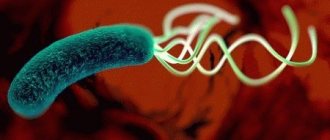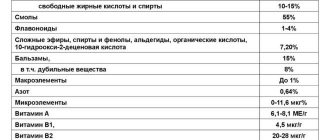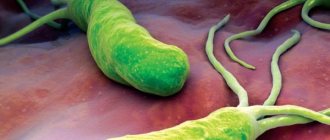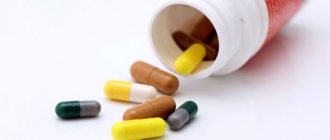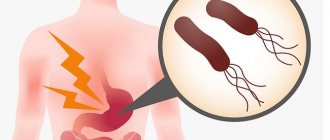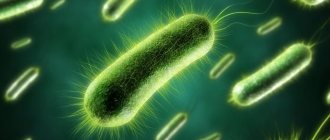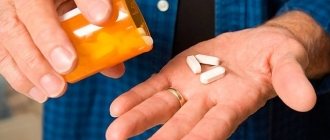Most people suffering from ulcers or gastritis are carriers of a unique and very dangerous bacterium - Helicobacter pylori. This microorganism can cause serious disturbances in the functioning of the gastrointestinal tract. However, when treating Helicobacter pylori with antibiotics prescribed by your doctor, you can easily get rid of the infection.
The bacterium Helicobacter pylori causes serious harm to the body if you do not try to get rid of it and do not take preventive measures. Today, medications also successfully help fight this microorganism.
What is the danger
So, why is it worth fighting helicobacteriosis:
- Scientists have proven the connection between the activity of a pathogenic microorganism in the gastrointestinal tract and ulcers of the duodenum and stomach.
- Studies have been conducted that have shown that infection is involved in the development of malignant tumors of the mucous membrane.
The stomach can indicate the presence of the Helicobacter bacteria by pain, which is caused by increased secretion of hydrochloric acid. In some cases, the process may occur asymptomatically.
Treatment of Helicobacter pylori without antibiotics: is it possible?
Studies have shown that treating Helicobacter without antibiotics will not have a positive effect. Quality treatment consists of three stages. The first row of the diagram is beneficial. But if this method is not effective, doctors prescribe the next series of drugs. When this option does not completely cope with the infection, third-line drugs are used. A treatment regimen without antibiotics will not completely control the bacteria. In some cases, it is necessary to add a fourth component, which has an anti-inflammatory effect. Although they are prescribed at the second stage, the composition of the drug has a positive effect on the walls of the organ, forming a protective film. After this, the pain subsides and inflammation is relieved. But, besides this, it is necessary not only to take pills, but also to lead a healthy lifestyle and eat right.
Forms
There are 2 types of helicobacteriosis:
- Hidden form. Often the patient does not suspect the presence of infection, since there are no signs. In this case, the person is a carrier of the infection. When favorable conditions are created, bacteria begin to actively multiply.
- The bacterium can be the culprit of gastritis or ulcers, the acute stage of which later becomes chronic. By the way, it is the deep-rooted disease that is one of the main symptoms of helicobacteriosis.
Even in the absence of signs, Helicobacter pylori harms the condition and functioning of the gastrointestinal tract.
Symptoms
Typically, a pathogenic bacterium makes itself known quite clearly:
- Pain localized in different parts of the abdomen, including behind the sternum. Pain occurs at any time of the day. The relationship between pain and eating depends on the location of the mucosal defect. With an ulcer, pain appears on an empty stomach, and goes away after eating.
- Frequent belching (the patient feels a sour taste and smell of rotten eggs from the mouth).
- Flatulence, problems with stool. With Helicobacter pylori infection, constipation for up to 48 hours and regular stomach upsets are observed.
- Impurities of blood and mucus in feces and vomit (which already indicates the development of complications).
- Nausea, vomiting, feeling of pressure in the epigastric region.
- Lack of appetite and weight loss for no apparent reason.
- In some cases, pink pimples on the face may indicate the presence of Helicobacter pylori infection.
The above symptoms may indicate various serious diseases, so if you have such symptoms, you should consult a doctor as soon as possible and get diagnosed.
How to cure a stomach?
This way of putting the question is actually correct. What difference does it make to us who needs to be personally “cleansed” in the stomach? Helicobacter, staphylococcus, streptococcus or something else?
We need it to not hurt, so we can eat in peace.
Therefore, the first step to healing is
Phytotherapy
No one knows how or why, but herbal remedies only kill pathogenic bacteria. The useful ones are not touched.
It is also desirable that the herbs are selected correctly. That is, they strengthened each other, removed some of each other’s side effects (if there were any).
You can drink chamomile, you can drink calendula, but the right herbal infusions will solve the problem much better and faster. The best recipe that I came across was from Sergei Valerievich Korepanov, candidate of medical sciences, herbalist with 30 years of experience.
In the end, I simply purchased a batch of this herbal collection from him for everyone who contacts me.
This is Fitol-7. Precisely gastrointestinal. Assembled and packaged at the ALFIT plant.
You need to drink it as indicated in the instructions. Courses. Course 1 month.
Usually, 2-3 courses are enough to recover or greatly improve your well-being.
At the same time, it relieves intestinal problems - gurgling, constipation, diarrhea, discomfort, flatulence, pain.
One package is just enough for a month.
Start with FITOL-7. Buy where it is faster or more convenient for you. Maybe there is one in your city, at the nearest pharmacy. You can buy it directly at Alfita.
If you want to thank me for my experience and advice, then just buy from me here...
The price is about the same everywhere.
The second step to healing is
Food
I don’t specifically write the word “diet” because that’s not what my method is about.
You don’t need to limit yourself harshly and you can’t. It will only get worse.
The rules are simple:
1. We only eat what we want, but
2. We eat those foods, those dishes, after which heaviness or pain in the stomach does NOT appear.
It can be fried (oddly enough and no matter what they write in smart medical books), or boiled, or steamed.
For example, very often, everywhere they say that oatmeal and jelly are a panacea and manna from heaven. But it “didn’t suit me” and that’s all. Everyone has their own set of enzymes. Choose products just for you.
Over time, as recovery begins, there will be fewer and fewer foods that make you feel “not so good.”
3. Don't overeat. Just watch how much you eat. How to monitor and what to build on? Do you know how much you usually eat? Of course you do. Not with your eyes closed, after all, at the table. Reduce by a quarter. Stop eating before you feel full.
Well, you understand - you don’t keep a quarter for yourself, but reduce the portion by a quarter. You eat ¾ of your usual portion.
4. Do not drink immediately after eating. You can drink a little. So that such a semi-liquid substance goes into the stomach. Or, if you really want to drink tea after eating, then drink it with a good bite. That is, so that not only liquid flows into the stomach, but such a semi-liquid substance. Do this. You will feel the result immediately.
5. Eat as little sweets as possible. It may seem to contradict point 1, but what can you do? It is very important. So-called fast carbohydrates as little as possible. Preferably around zero. These are sugar, soda, cookies, pastries, cakes, buns and bread made from premium flour, white rice, semolina. Replace fast carbohydrates with slow ones.
How is diagnostics carried out?
If you suspect the presence of the Helicobacter pylori bacterium, the following examinations must be carried out:
- Stool test for Helicobacter Pylori antigen. In most cases, laboratory technicians find particles of bacteria in the stool, which gives every reason to believe that their colonies populate the gastrointestinal tract.
- Blood test for antibodies. This diagnostic method cannot be called 100% accurate. The fact is that even after suffering a Helicobacter pylori infection, antibodies tend to persist for a long period of time.
- One of the best diagnostic methods is a breath test. Its advantages are high accuracy and low cost. However, it must be remembered that if the preparation rules are not followed, you can get a false result. To increase reliability, half a month before the diagnosis, you need to stop using antibiotics, anti-inflammatory drugs and a number of other drugs. And 3 days before the procedure, avoid drinking alcoholic beverages and smoking. Stop drinking caffeine-containing and carbonated liquids one day before.
- Often, in case of a stomach ulcer and suspicion of another disease of the intestinal tract, an endoscopic examination is prescribed. During this process, a biopsy is taken - a small sample of the mucous membrane. This diagnostic manipulation is one of the most highly informative
Feedback from doctors and their patients suffering from infection suggests that you should not rely on the results of one diagnostic method. To be on the safe side, specialists prescribe several examinations at once.
Helicobacter pylori infection in children: problem, analysis of generalized data
Chronic inflammatory diseases of the upper digestive tract are extremely common in the modern world. According to large-scale epidemiological studies, over the past decade their rate has increased by 37% and ranges from 100 to 550 per 1000 children [20]. In the pediatric population, chronic gastroduodenitis has a consistently high level in the structure of these diseases - ranging from 153 to 235‰.
Analysis of clinical and anamnestic data of patients living in the Moscow region made it possible to identify cardinal features of the clinical symptoms of chronic gastroduodenitis in children [20]. These included: the predominance of severe variants of the disease with frequent, prolonged exacerbations and a pronounced seasonal dependence of their occurrence, with a clear increase in the prevalence of the disease in girls, in early and preschool age.
The modern methodology used for quantitative assessment of risk factors (relative, attributable risk) enabled the authors to prove that chronic gastroduodenitis develops under the influence of a complex of ecopathological, biological and social factors, which confirms the relevance of developing a special program of medical and environmental rehabilitation [20].
Despite intensive scientific research and significant progress in the field of epidemiology, morphology, immunology, microbiology and other specialties, a unified pathogenetic concept of gastroduodenitis has not been developed. However, the pathophysiological complexity of the disease is becoming clearer. There is no doubt that the recognition of Helicobacter pylori as the etiological agent of most gastroduodenal diseases and the development of effective antibacterial regimens for the destruction of the pathogen are the most important achievements in modern clinical gastroenterology. Practical experience has confirmed that morphological changes that occur in the mucous membrane of the gastroduodenal zone undergo reverse development in the case of timely eradication of H. pylori [1, 2, 9].
The role of H. pylori in the etiology of gastric and duodenal ulcers has been most convincingly proven. The lifetime risk of developing it in infected people varies from 3% in the USA to 25% in Japan [4]. H. pylori eradication is an approved initial treatment for gastric and duodenal ulcers. Moreover, in a prospective longitudinal study including about 400 patients with ulcer bleeding, it was found that their relapses do not develop after eradication of H. pylori. If eradication was effective, then maintenance antisecretory therapy is not necessary [18].
Based on recent data, it is believed that Helicobacter pylori infection increases the risk of developing gastric cancer [5, 6]. In addition, Helicobacter pylori infection increases the risk of developing gastric MALT lymphoma. Eradication therapy is currently the standard approach to treating patients with stage I tumors and causes remission in approximately 70% of patients [5].
Accumulating evidence demonstrates an association between Helicobacter pylori infection and idiopathic thrombocytopenia. The incidence of helicobacteriosis in patients with idiopathic thrombocytopenia is 58%. A meta-analytic comparison, including 16 studies with a prospective cohort design and one randomized trial, showed a strong correlation between H. pylori eradication and an increase in platelet counts [17]. Eradication therapy allows for complete or partial restoration of platelet counts in approximately half of the cases. The reason for this fact may be the similarity of platelet antigens and H. pylori. It cannot be excluded that H. pylori infection may contribute to the development of iron deficiency and megaloblastic anemia. Recently, a clinical study demonstrated impaired iron absorption in infected patients and its recovery after eradication of the microorganism [7].
Many details of the process of colonization of the mucous membrane with H. pylori are not fully understood, but its mechanisms can be schematically represented as follows: chemotaxis towards the gastric mucosa - penetration of the bacterium into the mucus - adhesion to mucus receptors and layers associated with it - adhesion to epithelial cells - reproduction of bacteria associated with the mucous membrane.
H. pylori, persisting for a long time in the gastric mucosa, causes a number of pathochemical changes and constant antigenic stimulation. Antigen-specific and antigen-nonspecific responses of the immune system to H. pylori infection may control the progression of infection, but may also be involved in the development of damage to the gastric mucosa. In this situation, a reorganization of the cytoskeleton of epithelial cells and a number of other changes occur: epithelial cells respond to this by producing cytokines - interleukin-8 and some other chemokines. These cytokines also lead to the migration of leukocytes from the blood vessels, and the active stage of inflammation develops. Activated macrophages secrete interferon gamma and tumor necrosis factor. The latter sensitize the receptors of lymphoid, epithelial and endothelial cells, which in turn attracts a new wave of cells involved in immune and inflammatory reactions to the mucous membrane. Catalase and superoxide dismutase produced by H. pylori neutralize phagocytes, allow the microbe to avoid phagocytosis and promote the death of polymorphonuclear leukocytes. Active oxygen metabolites of neutrophils have a damaging effect on gastric epithelial cells. The created vicious circle affects the structure of the epithelium and forms a chronic pathological process in the mucous membrane, which subsequently leads to disruption of the normal physiological regeneration of the glandular epithelium. It has been proven that the microorganism causes disregenerative processes: it affects the proliferation and apoptosis of epithelial cells of the gastric mucosa. According to modern concepts, classic antrum gastritis with mononuclear infiltration of the lamina propria of the gastric mucosa is a consequence of the interaction of gram-negative bacteria with the host body. Today, there is a point of view according to which the nature of the inflammatory response, its intensity and the long-term effects mediated by it (atrophy, hypochlorhydria, development of distal gastric cancer) are determined by the host genotype. It has been established that a worse prognosis can be expected in IL-1B-31 T/T homozygotes.
Considering the mechanisms of development of pathophysiological reactions in the occurrence of diseases associated with H. pylori, it is necessary to assess the role and place of Helicobacter pylorus in the entire symbiont endoecosystem of the body. The unconditional importance of the state of the microbial ecology of the digestive tract for the colonization of the stomach by H. pylori and the development of the pathological process associated with these bacteria is indicated by the observations of Japanese researchers who showed that oral infection of germ-free rats with H. pylori was never accompanied by colonization of the gastric mucosa of animals and the occurrence of histological changes. Demonstrative are our own data (2001), according to which in the studied microbiotope - the large intestine - there was a decrease and change in the properties of indigenous microflora, modification of the general microbial contamination and the appearance of opportunistic microorganisms unusual for this biotope, a shift in microbial communities towards the associative growth of gram-negative bacteria (which are more resistant to the antibacterial action of the environment and exhibiting a more pronounced tendency to parasitism compared to gram-positive ones). In the microbiota of the colon, the frequency of low titers of bifidobacteria (71.4%) prevailed over the population size of lactobacilli (55.2%), more Klebsiella and fungi of the genus Candida were sown. The obtained results of impaired microbial colonization of the microbiotope under study gave us grounds to classify dysbiosis as a biomarker of a decrease in the overall colonization resistance of the digestive tract.
Helicobacteriosis is the most common chronic bacterial infection in humans and has both ethnographic (characterizing race) and socio-economic determination. To date, it has been proven that H. pylori infection in different regions of Russia has a very wide range of variation and ranges from 72% to 95%. The results of modern epidemiological studies in Siberia indicate that H. pylori infection begins in early childhood, reaching 33.3% by 10 years of age and 56.3% by 17 years of age, which is fully consistent with data obtained in other territories of Russia and neighboring countries: in St. Petersburg, 48% of those examined aged 15–19 years were infected; in Estonia, 60% of children aged 15 years were seropositive. Noteworthy is the fact that the frequency of detection of H. pylori among Russian adolescents is significantly higher than in developed countries. For example, the proportion of seropositive children aged 10–15 years ranged from 6.6% in New Zealand, 11% in the UK, 13.4% in Italy, 16.1% in Sweden, to 17.9% in the USA. As for developing countries, H. pylori infection occurs in Albania in 96%, India - 84%, China - 67%, Czech Republic - 63%, Mexico - 55.3% of adolescents. The modern methodology used for comprehensive assessment of risk factors made it possible to determine the association of H. pylori with socio-economic conditions, primarily with living in poor housing, low levels of education and physical labor of parents, and low quality nutrition. Of course, the established fact that the main source of infection is the direct contact of children with infected persons is important for everyday practice, and, as studies conducted in recent years have shown, this source is usually family members.
There is evidence that children become infected from their parents. Using serological studies of H. pylori conducted among the population of Turkmenistan (2003), it was found that immediately after birth a significant proportion of children (49%) had antibodies to H. pylori, by the year their share decreased by almost 2 times (26% ), and then gradually increased in each age group: by 5 years - 46%, by 10 years - 53%, by 14 - 82%.
When studying the prevalence of H. pylori-associated diseases in childhood, the dependence of infection on the duration of chronic gastritis was established, for example, in patients with a short history of the disease, H. pylori is detected in 15% of cases, while when the disease lasts more than 5 years, the pathogen is detected in 70% . Studies conducted in China, the USA, and Finland have shown that the annual increase in the incidence of H. pylori-associated gastritis is approximately 1%.
Cross-sectional clinical and epidemiological studies conducted in Russia in areas with different levels of anthropogenic pollution also confirm the high prevalence of H. pylori-positive chronic antral gastritis in children, but this figure is extremely varied and ranges from 53% to 90%.
Numerous publications indicate that H. pylori infection is the cause of all the most severe forms of gastroduodenal pathology in children. Most often, H. pylori is found in erosive (86%) and hypertrophic (82%) gastritis, somewhat less frequently in other forms of gastritis: subatrophic (60%), atrophic (58%) and superficial (49%). In duodenal ulcers, H. pylori is isolated more often (91–100%) than in gastric ulcers (70–100%).
Thus, H. pylori infection is of global importance and is widespread among the pediatric population throughout the world. Most researchers agree that H. pylori infection is usually acquired in childhood.
Significant progress has been made in the development of treatment regimens for H. pylori infection, a number of which are generally accepted and recommended at national and European levels. When prescribing therapy, we are guided by international recommendations for the treatment of H. pylori-associated gastroduodenal pathology (Maastricht-3, 2006), according to which the general course of treatment should be increased to 10 or 14 days. However, the use of 7-day regimens is possible and indicated if their effectiveness is proven in a particular region. In the Moscow region, over the past 15 years, anti-Helicobacter triple seven-day therapy (De-Nol + Amoxicillin + Furazolidone), which has 86% effectiveness, remains one of the most widely used in pediatric practice.
As stated above, H. pylori infection, affecting the body, leads to an imbalance in the microflora of the colon, which is aggravated after oral administration of antibiotics. The data obtained to date indicate that after anti-Helicobacter therapy, all patients experience a disturbance in the intestinal microbiocenosis, and clinical signs of dysbiosis are detected in 45.5% of patients. Thus, according to our data, when examining stool for dysbacteriosis in patients with H. pylori-associated gastritis receiving combination therapy, there was a deficiency of normal colon microflora, combined with the growth of opportunistic microorganisms, including fungi of the genus Candida [19]. The latest study conducted by E. V. Kanner [3] confirmed the position that exacerbation of chronic gastroduodenitis associated with H. pylori infection is accompanied by gross disturbances in the composition of the normal flora of the colon in children. When studying the metabolite status of coprofiltrates, a decrease in the relative content of acetic acid, an increase in the proportion of propionic and butyric acid, a change in anaerobic indices and the ratio of acid isomers to the ratio of unbranched acids were established. It was found that standard anti-Helicobacter therapy aggravates microecological imbalance in the intestines in 57.1% of patients. A very important practical aspect of the work concerns the advisability of prophylactic administration of pre- and probiotics, enterosorbents with a proven cytomucoprotective effect from the first days of the start of Helicobacter eradication therapy, which reduces the risk of developing antibiotic-associated diarrhea by 10 times [3].
Many questions remain unanswered regarding whether children should be given probiotics during antibiotic therapy. Meta-analyses suggest a modest benefit from supplementation with a single probiotic strain, such as Saccharomyces boulardii or Lactobacillus GG, or a combination of probiotics (such as Bifidobaterium lactis and Streptococcus thermophilus) for the prevention of antibiotic-associated diarrhea [10, 11, 12]. Currently, there is no objective data on the effectiveness of administering other probiotic strains to children.
Saccharomyces boulardii is a non-pathogenic probiotic yeast originally isolated from the lychee fruit of Indonesia and first used to treat diarrhea in France in the early 1950s. The lyophilized form finds wide clinical use in Europe, Asia, Africa, Central and South America. Preclinical and experimental studies have demonstrated the anti-inflammatory, antibacterial, enzymatic, metabolic and antitoxic activity of the drug. Saccharomyces boulardii has a natural resistance to antibiotics and gastric acidity, which is very important. The effectiveness of Saccharomyces boulardii is due to its direct blocking effect on the growth of pathogenic strains. By secreting protease (54 kDa), the probiotic neutralizes certain bacterial toxins, other enzymatic actions are carried out by the release of polyamines, resulting in an increase in the amount of disaccharides (lactase, sucrose, maltase, aminopeptidase) produced by the brush border of microvilli. An increase in the secretion of polyamines stimulates the maturation of enterocytes and helps achieve maximum absorption of glucose onto their membranes. A recent randomized, double-blind, placebo-controlled study demonstrated the effectiveness of Saccharomyces boulardii in children with acute gastroenteritis and the relationship of the probiotic with the body's immune response [12]. A significant significant increase in CD8 levels in the group of children receiving Saccharomyces boulardii indicates the proinflammatory activity of the probiotic, leading to the release of cytokines and activation of CD8 cells, which, apparently, helps limit the infectious process. This study is consistent with the results of other authors, according to which a slight increase in TGF-beta and a decrease in TNF-alpha was detected (by a negative feedback mechanism, proinflammatory cytokines stimulated by CD8 affect the level of TNF-alpha). Immunological changes were found in serum IgA and CRP (C-reactive protein). A significant significant increase in the level of the first indicator and a decrease in the second compared to the initial values also confirms the important ability of the probiotic to reduce the inflammatory process.
According to published data, Saccharomyces boulardii is effective as a preventive and therapeutic agent for diarrhea caused by antibiotics, Clostridium difficile, chronic diarrhea due to giardiasis, amebiasis, traveler's diarrhea, in patients with diarrhea on parenteral nutrition, in patients with HIV infection . However, the main indication for use of the drug is acute diarrhea in children and adults. Many reports clearly show that the probiotic Saccharomyces boulardii reduces the duration of diarrhea (normalization of stool consistency and frequency) and hospital stay by approximately 24 hours [13, 14, 15, 16].
The multifaceted mechanism of action and effectiveness of Enterol® 250 in relation to Bifidumbacterin in the complex therapy of Helicobacter-associated gastroduodenitis in children were demonstrated in our study [19]. Patients were randomized into 2 groups: group 1 (n = 23) - received the De-Nol regimen (240 mg), Flemoxin Solutab (1000 mg), Furazolidone 200 mg, Enterol® 250 mg 2 times a day for 7 days and then De- Nol 2 weeks and Enterol® 3 weeks: group 2 (n = 36) - Furazolidone 7 days, then De-Nol and commercial strains of Bifidumbacterin 10 doses 3 times a day for 4 weeks. The immediate results of treatment were assessed based on a combination of clinical, laboratory and instrumental data. The treatment was successful in the first group of children; the use of Enterol® had a significant effect on the rapid stabilization of the patients’ condition and the disappearance of gastrointestinal manifestations of dysbiosis. A clear elimination effect of the probiotic was obtained against Klebsiella, Citrobacter, hemolyzing strains of Escherichia, fungi of the genus Candida, which was in turn accompanied by normalization of the quantitative content of bifidobacteria, lactobacilli, Escherichia coli and enterococci. Good dynamics were noted in the coprograms: the amount of undigested muscle fibers, plant fiber and starch grains decreased, and iodophilic flora was eliminated. The following evidence was obtained of the benefits of complex therapy with Enterol® 250. This probiotic, prescribed to the patient from the first day of taking anti-Helicobacter drugs, allows you to “protect” the indigenous microflora, reduce the risk of developing more severe dysbiosis provoked by the iatrogenic interference of the antimicrobial drugs used, and significantly influence the effectiveness triple therapy with a basic bismuth drug (the eradication rate according to the protocol was 91.3% in group 1, respectively, in group 2 - 83.3%).
Thus, high therapeutic efficacy, excellent pharmacological properties, the possibility of use together with other drugs, a high safety profile, and a convenient dosage regimen make Enterol® the drug of choice for the prevention and correction of dysbiotic disorders that worsen the course of gastroenterological diseases in children.
In conclusion, I would like to present the multi-level treatment program we have developed for children with H. pylori-associated diseases. The first level is a thorough analysis of the clinical symptoms of exacerbation of chronic gastroduodenal pathology. The second level is the primary diagnosis of H. pylori infection: fibrogastroduodenoscopy (FGDS) + biopsy (urease “helpel test” + histological examination). Third level measures (7 days) - eradication of H. pylori infection: De-Nol + Amoxicillin + Furazolidone + Enterol®. Level four measures (3–5 weeks) - restoration of the morphofunctional state of the mucous membrane of the stomach and duodenum with the help of De-Nol.
For questions regarding literature, please contact the editor.
N. I. Ursova , Doctor of Medical Sciences, Professor
MONIKA them. M. F. Vladimirsky , Moscow
Start of treatment
Before the doctor selects a treatment regimen, he must prescribe a test that determines the sensitivity of the bacterium to antibacterial agents. This will help you choose the right drugs to kill the bacteria.
Principles of effective antibiotic treatment for Helicobacter pylori:
- Initially, you should undergo examinations to identify bacteria in the gastrointestinal tract.
- It is advisable that not only patients, but also their loved ones and relatives living with the patient undergo H. Pylori therapy. In this case, it is advisable to examine household members.
- After drug therapy, control diagnostics are carried out. If a pathogenic microorganism is newly detected, then repeated use of antibiotics is recommended for 7-14 or more days. In this case, it is likely that previous antibacterial agents will be replaced with new ones. The duration of the course is determined by the doctor.
- Today, the most effective is to take three or even four drugs at once.
If drug therapy does not work, Helicobacter can be treated in another way. American scientists conducted an experiment on 18 patients, during which they found out that the culprit of many diseases of the gastrointestinal tract is vulnerable to light. Phototherapy has shown high effectiveness. However, a number of additional studies still need to be conducted. After them, it will become clear whether it is possible to replace antibacterial therapy with laser.
Antibacterial therapy
Antibiotics are mainly taken for gastritis and the presence of H. Pylori in the gastrointestinal tract.
However, there are other indications:
- stomach or duodenal ulcer;
- maltoma and gastrectomy;
- gastrointestinal tumors;
- lack of iron in the body;
- development of anemia.
No matter how strange it may sound, drug therapy is not carried out in all cases. It is only necessary if there is a risk of developing an ulcer or if there are nonspecific symptoms.
Principle of antibiotic selection
Several drugs are prescribed simultaneously to treat the infection. There are different lines of medications against Helicobacter pylori.
Their choice depends on the following factors:
- Age of the patient with H. Pylori.
- The body's reaction to antibiotics (for this it is necessary to conduct a drug sensitivity test).
- Contraindications to taking certain groups of medications. For example, some cannot be taken if you have kidney failure.
The doctor should also select a remedy, taking into account:
- Its ability to kill colonies of bacteria in an acidic environment created by exposure to hydrochloric acid.
- The bioavailability of the antibiotic must be high.
- Minimal number of side effects (this is especially important for the treatment of children and pregnant women).
Antibiotics for Helicobacter pylori infection should be taken only as prescribed by a doctor and under his supervision. After completing a course of therapy, a re-diagnosis is required to ensure that the treatment was successful.
Treatment of Helicobacter pylori with antibiotics
The bacterium Helicobacter pylori is widespread, known as a dangerous microorganism that is not afraid of hydrochloric acid. It provokes the appearance of gastroduodenitis. It was revealed that control measures are based on different drugs. But, most antibacterial drugs do not bring much benefit. Not all of them penetrate under the mucous layer in which the bacterium is located. With advanced disease, oncology may develop. For this reason, it is important to find out which antibiotics to treat Helicobacter.
Clarithromycin for Helicobacter pylori
This drug is a 14-membered macropid derivative of erythromycin, corresponding to the level of activity and method of use. But, compared to erythromycin, it is more resistant to the effects of acid. A drug with a long elimination period. There is a triple antibiotic treatment regimen.
Clarithromycin is prescribed for adults - 250 mg (1 capsule) twice a day. Take tablets for 6 to 14 days. If a severe form of the disease is present, the dose is increased to 2 capsules twice a day. Take the medicine with water, regardless of meals.
Azithromycin for Helicobacter pylori
The drug has a wide spectrum of action and is bacteriostatic. It reduces and inhibits peptide translocase and protein synthesis even at the stage of translation. It also slows down the growth of bacteria, prevents their reproduction, and has a bactericidal effect. It acts on pathogens both intracellular and extracellular, which are caused by sensitive pathogens of duodenal ulcer, which is associated with Helicobacter pylori.
It is necessary to take the medicine with caution. Pregnant women can only take it if the benefits of treatment outweigh the risks. It is not recommended for use in children who have severe dysfunction of organs such as the kidneys or liver. Swallow regardless
Tinidazole: effective against Helicobacter
The drug is active against anaerobic bacteria, microaerophilic Helicobacter pylori or mixed aerobic-anaerobic infections. Antibiotics from Helicobacter are combined with it.
Not recommended in the first trimester of pregnancy. It is possible only if it is impossible to do without taking medications and the positive result outweighs the risk to the child. Children under 12 years of age are not allowed to take the medicine. Adults – 4 tablets (500 mg) 1 time per day. Children – 50 mg/kg once a day.
Levofloxacin
Prescribed for acute sinusitis, Helicobacter pylori, infections caused by pathogens sensitive to levofloxacin. The dose is determined by the attending physician.
Duration of therapy is from a week to two. Take orally – 250 – 750 mg once a day before or between meals. The solution is administered intravenously, slowly. Within an hour up to 500 mg, and 750 mg up to an hour and a half.
Tetracycline
This drug stops protein biosynthesis and combines in an unusual way with the 30‑S subunit of the ribosome. It has proven to be effective against H. Pylori. Intensity is maintained even at low pH levels. The medicine is included in the second-line treatment system.
Acts as a bactericidal drug, increases the level of resistance of the stomach lining to negative effects. The protective functions are reconstructed, preventing relapses of the disease. While taking it, it is better not to drink juices or milk. The course of treatment is up to two weeks. To enhance the effect, antisecretory tablets are added. But such treatment is not enough; only combined treatment can achieve a cure in 980% of cases. Therefore, a special treatment regimen for Helicobacter with antibiotics + denol is being drawn up.
Amoxicillin for Helicobacter
This is an antibiotic belonging to the series of penicillins; its dynamics are very similar to ampicillin. It behaves stably in an acidic environment. It acts locally as well as systemically. Helicobacter pylori shows sensitivity to the drug, but an integrated approach is required for quality treatment.
Use the medicine 4 times a day at 500 mg, or 2 times at 1000 mg. Available in tablet or suspension form, it is absorbed quickly and almost completely. Food intake does not depend on the use of medication.
Metronidazole
Helicobacter is sensitive to the drug. After use, a high concentration of the drug is formed in the stomach acid. This allows you to achieve a good therapeutic effect. During the metabolic process, “metronidazole” undergoes activation by nitroreductase, which leads to the elimination of the DNA structure of the bacteria, after which they die. Dissolves quickly and well, in about 1 hour.
The elimination period is 8 – 10 hours. Take for adults 2 tablets per day (500 mg). Children are prescribed the drug depending on body weight (30 mg in 3 doses).
Rifambutin
The antibiotic is active and is located both inside and outside the cells. It is used both for the treatment and prevention of gastrointestinal diseases, for the eradication of the bacterium Helicobacter pylori. Medicine is often recommended when first- and second-line regimens are ineffective.
It is used regardless of food intake. For adults, 2 capsules (300 mg) once a day. After administration it is well absorbed. It is evenly distributed in other organs and tissues and accumulates in significant concentrations intracellularly.
List of drugs required for therapy
The list of medicines includes several groups:
- Drug therapy involves the prescription of bismuth preparations (for example, De-nol). However, there are treatment regimens where these drugs can be dispensed with.
- The antibiotics themselves. Most often, domestic doctors prescribe: Augmentin, Flemoxin, Klacid, Ormax. Combination treatment with two or more types of antibiotics is possible (usually if bismuth preparations are not prescribed).
- Antisecretory drugs: Ranitidine, Omez, Lansoprazole, Gastrocepin and others.
- Antimicrobial medications (if necessary) - for example, Macmiror.
- Enzyme preparations (Mezim, Pangrol, Creon) are prescribed to improve digestion and relieve excessive stress on the pancreas. Most often, treatment of gastrointestinal diseases accompanied by the presence of Helicobacter pylori infection cannot be done without them.
- Antibiotic therapy is necessarily accompanied by the use of lacto- and bifidobacteria (Bifiform, Linex, Acepol) to normalize intestinal function and (or) means to prevent the occurrence of candidiasis (Fluconazole, Nystatin, Pimafucin, etc.).
In most cases, the outcome of drug therapy cannot be predicted. This is explained by the bacteria's resistance to drugs. After all, many people uncontrollably take antibiotics to treat all kinds of diseases. However, when combined therapy is prescribed, the result is positive in most cases. In difficult situations, it is possible to take tests to determine the sensitivity of the H. Pylori bacterium to certain antibacterial agents.
There is currently no vaccine against Helicobacter pylori. Nevertheless, several years earlier, the best scientists in the world began to develop a vaccine. Experts wanted to ensure that the drug could be taken during meals. However, identifying a product that would be effective in acidic conditions has proven problematic.
Example of a treatment plan
Since the most common antibiotic treatment regimens for Helicobacter pylori infection include taking two main medications, the doctor will most likely suggest you take De-nol in combination with another antibiotic he prefers or the Klamox + Claricin regimen.
Only your attending physician can recommend the exact types of medications that are right for you, the dosage and duration of treatment. Don't self-medicate!
Bismuth preparations
This treatment regimen for Helicobacter pylori with antibiotics is most often used. The doctor prescribes one antibacterial drug and its complementary agent.
Clarithromycin or Tetracycline. Both medications must be taken twice daily. The average dosage for an adult is 0.5 g. A proton pump inhibitor or a histamine receptor blocker (Cimetidine or Roxatidine) is also taken. The exact dosage is prescribed by the attending physician.
Antibiotic therapy
Usually one type is prescribed (Amoxicillin, Tetracycline, etc.) and two additional drugs (Famotidine, Quamatel or Ranitidine). The course of antibacterial medications according to this regimen lasts at least 10 days.
In this case, the specialist has the right to increase the dosage of the funds and change the two-time dose to four times a day.
Additional medications
Analyzing the third treatment regimen for H. Pylori with antibiotics, it is worth noting that it is combined. That is, it implies the simultaneous use of two antibacterial and two additional drugs. In addition, proton pump inhibitors and histamine receptor blockers are used.
A specialist may also prescribe Venter or Misoprostol. These medications protect the walls of the stomach from the aggressive effects of hydrochloric acid.
During the treatment period for Helicobacter, the doctor prescribes vitamins and prebiotics. After all, it has long been known that antibacterial drugs kill both pathogenic microorganisms and beneficial ones.
Possible side effects
Approximately 15-20% of patients treated with H. Pylori antibiotics experience side effects.
The main ones include:
- abdominal pain;
- cough;
- diarrhea;
- metallic taste in the mouth;
- allergic reaction;
- nausea and vomiting;
- headache and dizziness;
- photosensitivity;
- Women may experience vaginal discharge.
In 5% of cases, negative consequences such as hepatitis, baldness, heart rhythm disturbances, and toxic damage to the central nervous system are observed.
How to diagnose the disease?
The first step to developing a program is a survey. It is carried out primarily for people at increased risk. There are different diagnostic options based on the level of infection activity. The property of Helicobacter is the breakdown of urea with the formation of carbon dioxide and ammonia, this distinguishes it from other microbes. A patient with abdominal pain should first consult a gastroenterologist. If the worsening situation is localized in the upper sections, fibrogastroduodenoscopy is prescribed. This is the main examination method that allows you to see changes in the mucosa, including ulcerative defects.
During this procedure, a biopsy sample is taken. It consists of a histological examination, as well as a urease test, which determines the presence of the bacterium Helicobacter pylori. If there is an infection in the biopsy sample, it is determined using the urea splitting reaction using a paper indicator. It contains a complex chemical composition that changes color when bacteria are present.
This option is very convenient, practical, the result is ready in 2 – 3 minutes. There is also a breath test, using which you can detect the presence of bacteria by exhaled ammonia.
Is treatment possible without antibiotics?
There is an opinion that you can get rid of Helicobacter with the help of folk recipes and natural preparations.
Detection of Helicobacter pylori is a direct indication for antibiotic therapy. But for prevention, herbal medicine itself is very effective.
Helicobacter pylori is a smart bacterium that can survive even in acidic environments where most other organisms die. Therefore, only taking infusions from the arsenal of traditional medicine will not lead to anything good. And some of the drugs can even worsen the patient’s condition.
Nutrition for infection
In addition to taking antibiotics, it is recommended to adhere to the basics of a balanced diet and eat 5-6 small meals a day.
Experts advise remembering the principles of diet:
- Chew food thoroughly. If this is difficult for the patient, it is recommended to eat ground food.
- Limit the use of salt in food (no more than 2 teaspoons per day). To control, it is advisable to season the dish already on the plate.
- Do not eat too hot or cold food.
- During the treatment of infection, drink at least 2 liters of water per day.
- Avoid fatty, fried foods.
- Not to starve. All newfangled diets lead to irritation of the gastric mucosa.
To achieve stable remission, it is recommended to adhere to these nutritional rules for 1-1.5 years.
Disease prevention
Few people know that a person does not develop immunity to Helicobacter pylori infection, so another infection is possible.
If you want to avoid repeated therapy, experts recommend:
- Immunity to Helicobacter pylori infection is not developed, so re-infection is possible. Most often this happens at home. Using personal utensils will help you avoid this.
- Observe hygiene rules. Teach your child to wash their hands too.
- Remember that bacteria are transmitted through saliva. Therefore, kissing people whose health you are not sure about can cause infection. Children should not be allowed to share fruit on the “let me take a bite” principle, and girls are not recommended to share lipstick with a friend.
- A passion for alcohol leads to the active functioning of the microorganism. The same applies to smoking (including passive smoking).
- Teach children not to eat unwashed vegetables and fruits.
- Take your pet to the veterinarian for regular checkups. Until recently, there was no information that you can get the infection from animals. However, there is now every reason to believe that cats, dogs, monkeys and pigs carry the pathogenic bacterium.
- When you first notice symptoms of infection, consult a doctor immediately.
Helicobacter is transmitted from mother to child not through the placenta, as pregnant women sometimes think, but only by airborne droplets. Therefore, it is necessary for a mother with an infection to avoid trying food and feeding the baby with the same spoon.
For such an infection, drug therapy with antibiotics is carried out. Remember that the drug should be prescribed only by the attending physician, who also controls the process of eradication of the pathogenic microorganism. Remember to eat a balanced diet and do not ignore taking a repeat breath test.
